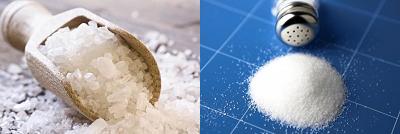- Updated on November 1, 2020
![]() By Dr. Artour Rakhimov, Alternative Health Educator and Author
By Dr. Artour Rakhimov, Alternative Health Educator and Author
Sea salt vs table salt production
 Sea salt is usually produced using solar evaporation of sea water or water from salt lakes. Production of table salt involves mining and use of vacuum pan evaporators for extraction at very high temperature.
Sea salt is usually produced using solar evaporation of sea water or water from salt lakes. Production of table salt involves mining and use of vacuum pan evaporators for extraction at very high temperature.
Sea salt vs table salt composition
As a result, both types of salt have over 99.9% sodium chloride with the same sodium content. However, sea salt, due to more gentle production methods, has a higher mineral content. For example, magnesium can be at the level of about 2,000 ppm (parts per million). Table salt has large amounts of iodine added (sufficient to produce health benefits), as well as an anti-caking chemical that contains aluminum.
Sea salt vs table salt: nutrition and health benefits
Even though nearly all people consume salt every day, there are virtually no studies that compared health benefits of sea salt vs table salt. After using medical search engines, only one such study was found. It was conducted at the University of Medicine and Dentistry of New Jersey, Maplewood. This study compared effects of tap water vs. distilled water and table salt vs. sea salt on blood pressure in rats over 4 month period of time. The abstract of this study is provided below.
November 2018 update. There is one more study now that found different health effects between sea salt and table salt: “Natural sea salt consumption confers protection against hypertension and kidney damage in Dahl salt-sensitive rats“.
Soviet and Russian Buteyko breathing doctors (over 150 medical professionals) suggested that sea salt health benefits are particularly noticeable in those people who produce large amounts of mucus (sputum or phlegm) due to their respiratory problems (asthma, bronchitis, cystic fibrosis, and so forth). They also suggested that table salt is not suited for human ingestion due to aluminum and due to other causes.
These doctors did not discover any adverse effects of large amounts of sea salt on most people, including those with high blood pressure. Furthermore, since most of their patients reported better well-being when using sea salt, leading Soviet physiologist Dr. KP Buteyko, MD, Ph.D., suggested using additional amounts of sea salt (up to 1/2-1 teaspoon per day) every day for increased-body oxygenation. Even people with severe gastritis, GERD, and other digestive problems do not have any adverse reactions to extra sea salt if they apply the following protocol.
Instructions to use sea salt for health benefits
Dissolve 1/2-1 teaspoon of sea salt in a glass of spring or purified warm (or room temperature) water. Sip it slowly on an empty stomach when you start using it. Later, after 1-2 weeks, you can use it after meals or at any other time. Additional suggestions are:
– People with serious kidney problems need to follow their guidelines related to daily sodium intake.
– People with asthma or inflammation of airways need to use warm water only.
– People with gastritis should sip it slowly on an empty stomach until they solve their health problems.
It seems that all evidence points out that table salt is not good for human (and even rat) health. It is much better to use only sea salt for human nutrition.
In order to avoid iodine deficiency, one can include a small number of seaweeds in a diet. Seaweeds have additional benefits due to the high content of trace and rare minerals.
Many researchers believe that sea salt when dissolved in purified or clean water, is able to restructure water-forming clusters, while table salt does not have this ability. Some Buteyko practitioners heavily emphasize benefits of supplemental-sea salt and nearly insist that they use additional-sea salt every day.
There are possible additional benefits when one breathes through sea salt or rock salt when using the Frolov device or Amazing DIY breathing device to increase body-oxygen content, especially for people with problems including the lungs and airways or with excessive mucus production.
Warning. Many health-conscious people and Buteyko students use only sea salt and do not use table salt (often at all). This can often a cause mild, moderate or serious deficiency in body reserves of iodine, with corresponding symptoms, such as more fatigue, goiter, sleepiness, mental depression, weight gain, and decreased body temperatures. For a simple test and solutions to this challenge, see a page about a useful and easy DIY iodine deficiency test.
References for sea salt vs. table salt differences
Flowers SW, Jamal IA, Bogden J, Thanki K, Ballester H, Hypertension induction in Dahl rats, J Natl Med Assoc. 1990 Dec;82(12):837-40. University of Medicine and Dentistry of New Jersey, Maplewood.
Lee BH, Yang AR, Kim MY, McCurdy S, Boisvert WA, Hypertension induction in Dahl rats, Food Nutr Res. 2016;61(1). Department of Food and Nutrition, School of Food Science and Technology, Chung-Ang University, Seoul, Korea.

